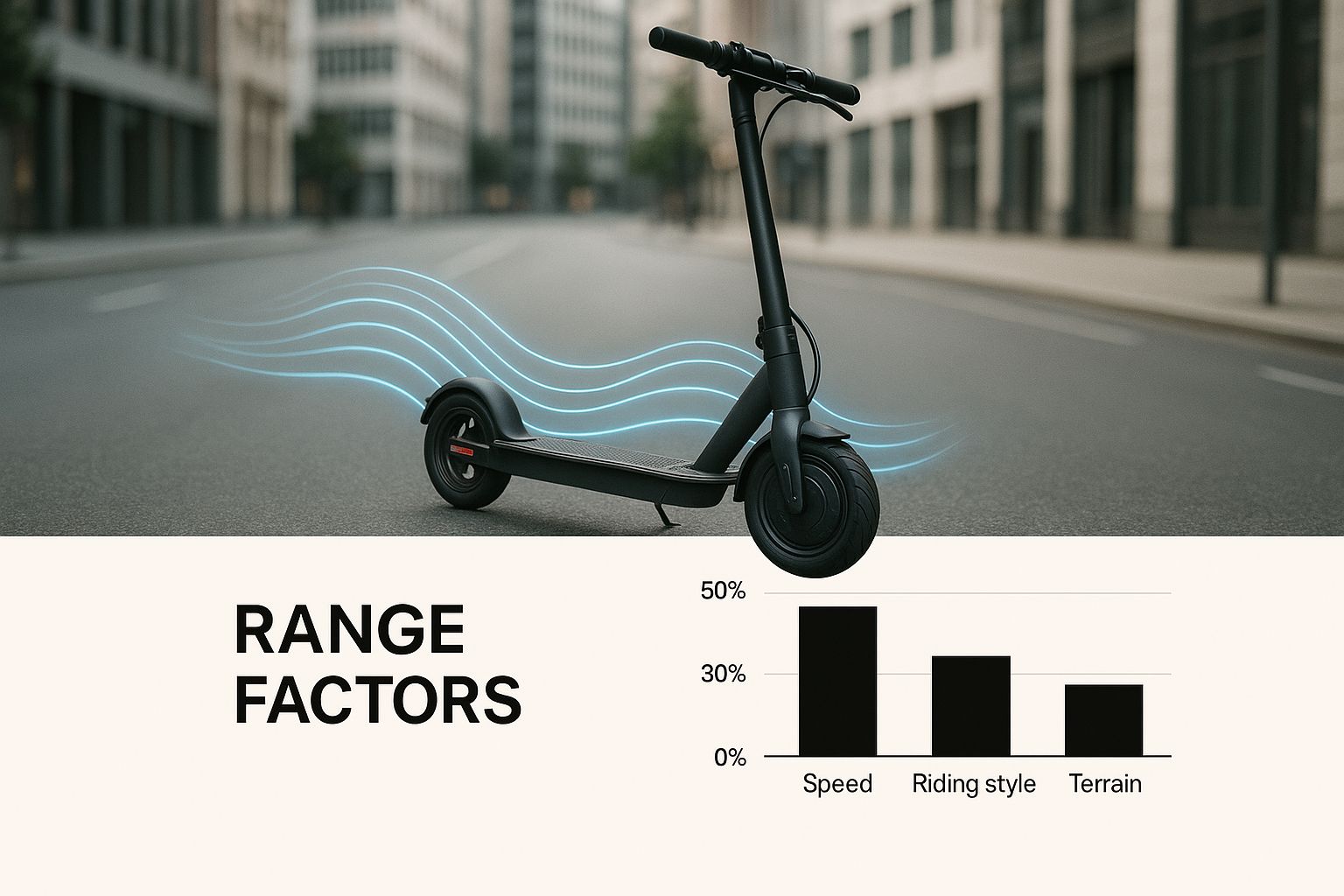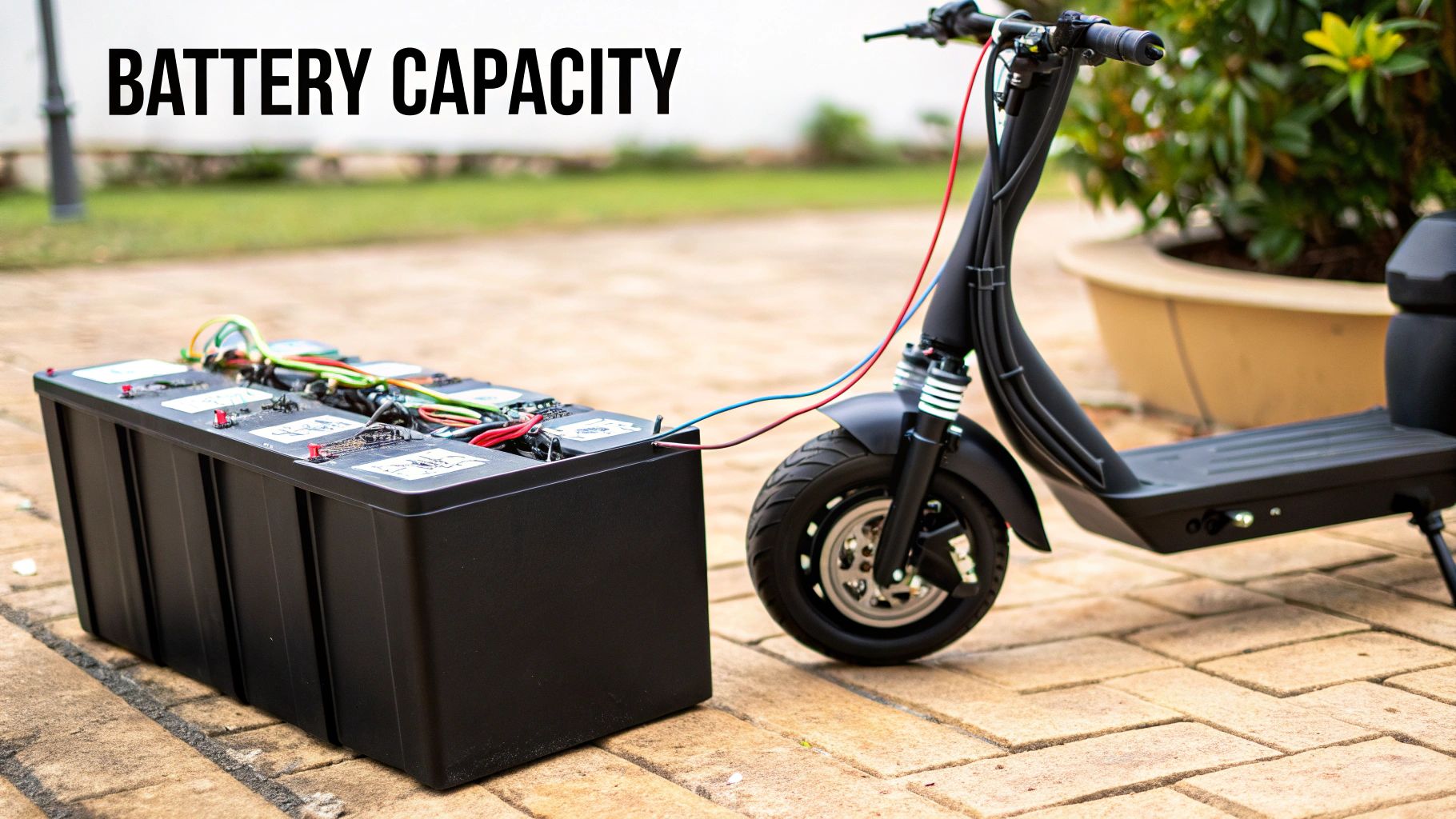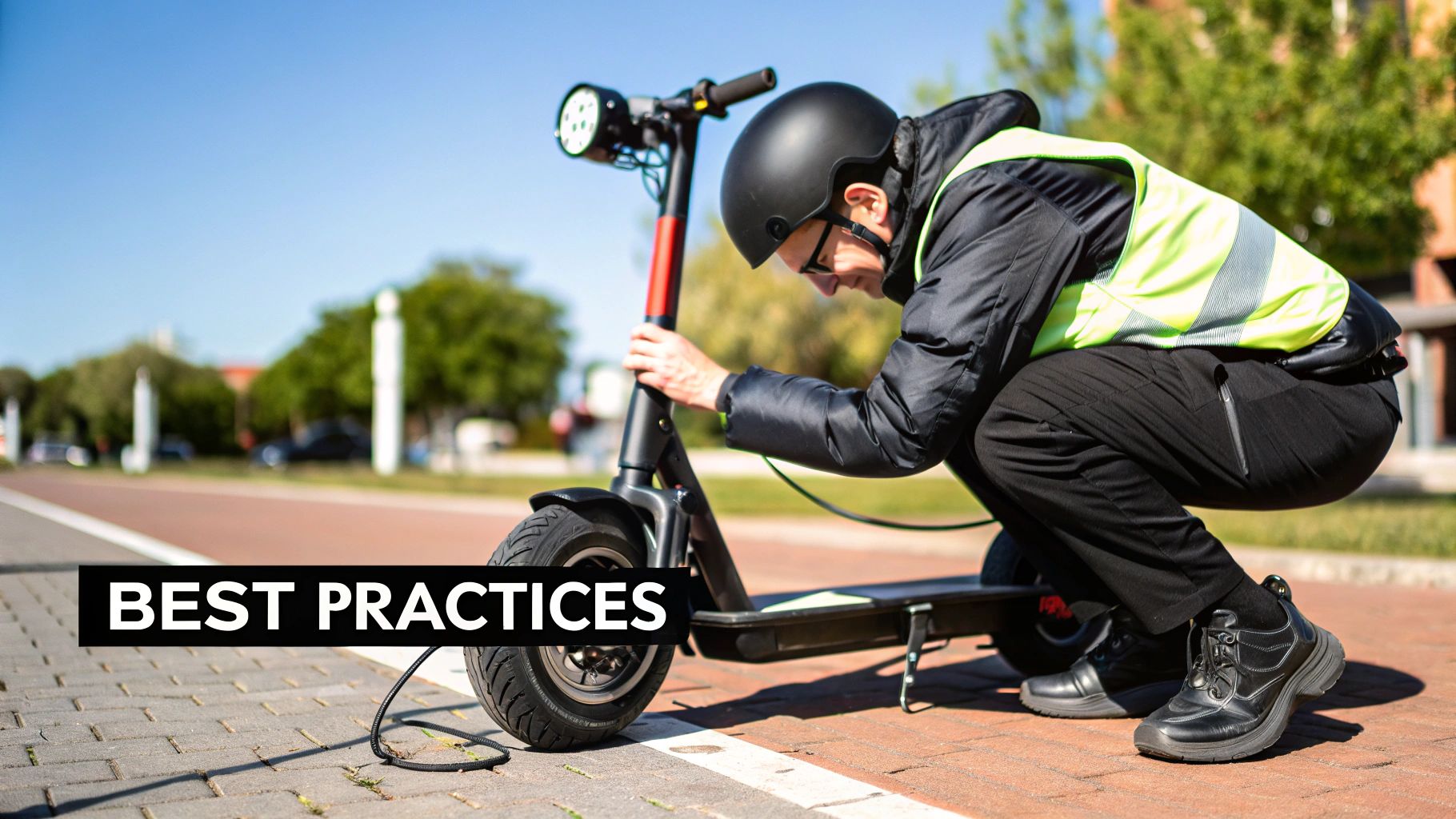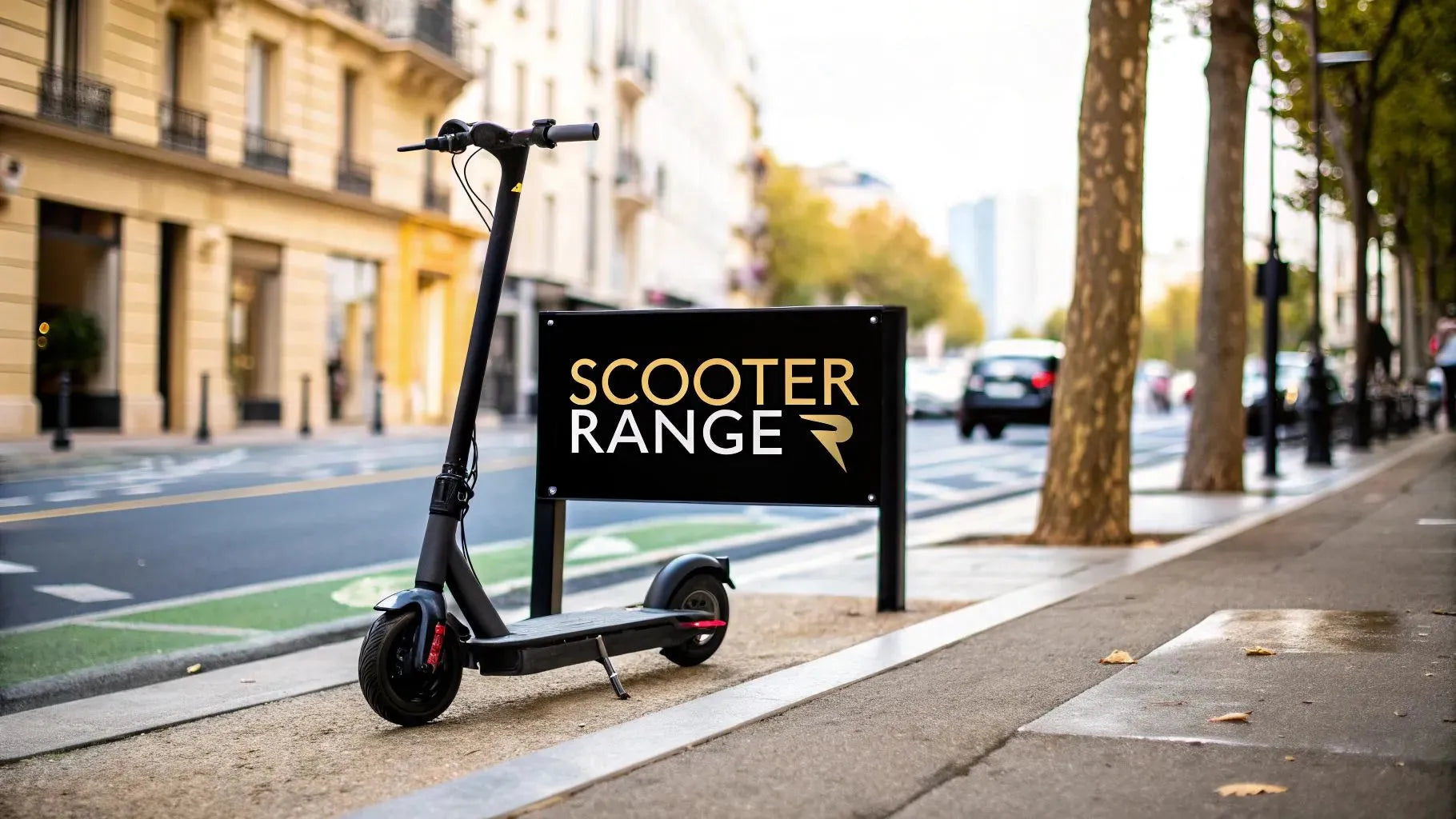So, you see an electric scooter advertised with a massive range and start picturing epic cross-city adventures. But then, reality hits when the battery dies halfway through your actual commute. What gives?
The secret is knowing that the advertised range and the real-world range are two very different beasts.
What Electric Scooter Range Actually Means
Ever feel a bit cheated when the impressive mileage on the box doesn't even come close to what you get on the street? You're not alone. Manufacturers test their scooters in a lab—a perfectly flat, windless, climate-controlled bubble that has zero in common with a typical ride through an American or Australian city.
Think of it like the fuel economy of a car. A carmaker might claim 30 MPG, but that’s based on ideal driving conditions. The second you get stuck in freeway traffic, climb a few hills, or load up the trunk with groceries, that number takes a nosedive.
It's the exact same story with scooters. The advertised electric scooters range is a best-case scenario, not a promise for your daily journey.
The real test of an electric scooter's range isn't what happens in a lab. It’s how it holds up on bumpy city streets, up steep hills, and against a stiff headwind on your way to work.
To figure out how far you can really go, you have to look past the marketing hype. The only benchmark that matters is your daily ride.
A whole host of factors come into play here, chipping away at that perfect lab-tested number. Everything from the weather to how aggressively you ride will affect how much juice you get from a single charge. Getting a handle on these variables is the key to beating range anxiety and squeezing every last mile out of your scooter.
The Real-World Factors Draining Your Battery
That shiny number on the box? Think of it as a perfect-world scenario. The moment your scooter hits the real pavement, with all its bumps, hills, and headwinds, that advertised range starts to look a little optimistic.
It helps to imagine your battery as a finite pool of energy. Every little challenge on your ride takes a sip. Some are tiny sips, but others are massive gulps that can drain your power surprisingly fast.
These real-world variables are what really determine how far you'll get on a single charge. This infographic breaks down the biggest energy hogs you'll run into on a typical ride.

As you can see, things like the hills on your route and the weight you're carrying aren't just minor details—they're the main characters in your range story. Let's dig into the most common range-killers you'll face out there.
Your Weight and Cargo
Honestly, the single biggest factor dictating your range is the total weight the scooter has to carry. That means you, plus your backpack, your laptop, and maybe that spontaneous grocery run on the way home. The heavier the load, the more muscle the motor needs to get you moving and keep you going.
This extra effort pulls way more juice from the battery, especially when you're accelerating from a stop or heading uphill.
A rider weighing 210 lbs (about 95 kg) will always get less mileage than a 145 lbs (about 65 kg) rider on the exact same scooter. It’s simple physics. This difference is especially stark on smaller, less powerful models. If you're looking for something that handles various loads well, this guide to the best lightweight electric scooters is a great place to start.
The Terrain You Ride
Where you ride is just as important as how much you weigh. Cruising along a perfectly flat, smooth path is a walk in the park for your scooter's motor. It can just hum along, barely breaking a sweat.
But the second you hit a hill? It's a different story.
Tackling a steep incline, like one of San Francisco's notorious hills, is the equivalent of a full-sprint workout for your scooter. The motor has to draw maximum power just to keep you moving, which can slash your expected range by up to 50% on particularly hilly commutes.
Here’s a quick look at the factors we've discussed so far and a few others that can really cut into your distance.
Real-World Range Killers at a Glance
| Factor | Description | Potential Range Reduction |
|---|---|---|
| Rider Weight | The heavier the rider and cargo, the harder the motor works. | 15% - 30% |
| Hilly Terrain | Climbing hills demands a massive amount of battery power. | 20% - 50% |
| Cold Weather | Low temperatures reduce the battery's chemical efficiency. | 10% - 40% |
| Aggressive Riding | Constant stop-and-go and full-throttle acceleration. | 15% - 25% |
| Strong Headwinds | The motor must overcome air resistance to maintain speed. | 5% - 15% |
| Low Tire Pressure | Underinflated tires increase rolling resistance on the road. | 5% - 10% |
As the table shows, a few of these factors combined can easily halve your manufacturer's stated range, so it's crucial to keep them in mind.
Temperature and Weather
Your scooter’s battery is a bit like you—it has a favorite type of weather. It performs best on mild, clear days.
Lithium-ion batteries get sluggish in the cold. During a chilly winter in Chicago or a cold snap in Melbourne, the chemical reactions inside slow right down, which reduces the total amount of power it can actually deliver. It's not uncommon to see your total range drop by 10% to 40% in freezing temperatures.
It's not just the cold, either. Riding into a stiff headwind is like a constant uphill battle; your motor has to work overtime just to keep you at your desired speed. Even wet roads can add a little extra rolling resistance, chipping away at your total distance one foot at a time.
How to Read Battery Specs Like a Pro

Glancing at a scooter's spec sheet can feel like you're trying to decipher a secret code. You'll see a jumble of letters like V, Ah, and Wh. But don't let them intimidate you—getting a handle on these numbers is your ticket to understanding a scooter's real-world performance and dodging any nasty range surprises.
Think of it like shopping for a car. The battery specs are basically the engine and fuel tank specs all rolled into one. Let's break down the three most important figures you need to know.
The Big Three Battery Numbers
These three metrics are the holy trinity of your scooter's power and, crucially, its potential electric scooters range.
- Volts (V): This is all about power. Think of it as the engine's muscle. A higher voltage means the motor can kick out more power, giving you quicker acceleration and the oomph you need to conquer hills.
- Amp-hours (Ah): This is the fuel tank's size. It tells you how much juice the battery can hold and deliver over time. More amp-hours means a bigger tank.
- Watt-hours (Wh): This is the most important number for range. It represents the battery’s total energy capacity—the true measure of how much fuel you actually have in the tank.
Calculating Watt-hours is super simple: just multiply the Volts by the Amp-hours (V x Ah = Wh). So, a scooter with a 36V, 10Ah battery has a total of 360Wh of energy. But another one with a 48V, 10Ah battery packs a much bigger punch with 480Wh, which will almost always translate to more miles on the road.
When you're weighing your options, the Watt-hour (Wh) figure is your best friend. A higher Wh number is the most reliable indicator of a scooter's long-distance potential. It cuts through the marketing fluff and tells you what really matters.
Why Higher Voltage Matters for Range
While Watt-hours give you the full picture of capacity, voltage itself plays a massive part in how your scooter feels and performs. It's no surprise that riders in North America and Australia are increasingly choosing higher-voltage scooters, often in the 60–96V range. These beasts not only deliver longer ranges but also mean you’re charging less often, making them perfect for serious daily commutes.
At the end of the day, understanding these numbers gives you the power to see past the flashy ads. It lets you properly compare electric scooter models and pick a ride that genuinely fits your life, whether you're zipping around the US, the UK, or down under in Australia.
Simple Tricks to Get More Mileage From Your Scooter
Alright, now that you know what's eating up your battery, let's talk about how to fight back. Squeezing every last drop of juice out of your electric scooter's range isn't about being a tech wizard—it's all about building smarter riding habits. Think of these as little tweaks that can add up to a seriously longer ride.
It’s a lot like getting better gas mileage in a car. Mashing the gas pedal and slamming on the brakes is a surefire way to burn through fuel. The same principle applies here. Gentle acceleration and letting yourself coast to a stop are your best friends when it comes to saving that precious battery life.
This smoother approach prevents the motor from chugging huge gulps of power, saving it for the journey ahead.
Habits That Boost Your Range
Beyond just riding smoothly, a few quick checks before you head out and some simple adjustments on the go can make a huge difference. Most scooters these days even have built-in features to help you go the distance.
The most powerful tool in your arsenal is often eco mode. Sure, it might limit your top speed a bit, but it dramatically cuts down on how much power the motor uses. This simple switch can easily add miles to your trip, making it perfect for those long, leisurely cruises.
Here are a few other easy wins:
- Check Your Tire Pressure: Seriously, this is a big one. Under-inflated tires create a ton of drag, making your motor work overtime. Keeping them properly inflated is probably the easiest efficiency boost you can get.
- Pick a Smarter Route: If possible, try to stick to flatter ground. A route with a bunch of steep hills will drain your battery way faster than a level path.
- Travel Light: Every extra pound matters. If you don't need that heavy laptop or a full water bottle in your backpack, leave it behind. The less weight the motor has to push, the further you'll go.
Don't forget about basic battery care—it's just as important as how you ride. You shouldn't leave your scooter plugged in for days after it hits 100%. And if you're putting it away for a while, try to store it with the battery at around 50-80% charge. This keeps it healthy for the long haul.
When you start combining these little tricks, that nagging range anxiety starts to fade. You’ll not only get more out of every charge, but you'll also help your scooter's battery live a longer, happier life. It's the small habits that make for a much better ride.
Why E-Scooter Use Varies Around the World

You might be looking for a scooter to handle your commute in Melbourne or Manhattan, but it's worth taking a step back to see the bigger picture. The global market gives us a fascinating look into electric scooters range, and understanding these differences can actually help you make a smarter choice.
The truth is, not all scooters are built for the same job. The biggest split comes down to geography and what a rider needs to do every day. In many parts of the world, especially in Asia, scooters are the primary way people navigate incredibly crowded cities.
The Asian Market's Short-Range Focus
In a city like Mumbai or Shanghai, the name of the game is agility and affordability for short, zippy trips. Riders there need something small and light to weave through chaotic traffic, not a long-range beast for a 20-mile suburban journey.
The numbers back this up. In 2023, the Asia-Pacific region absolutely dominated global sales, with the market valued at a massive USD 37.07 billion. This huge market is fueled by a demand for practical, short-range scooters that are a perfect fit for the local environment. You can dig deeper into the global e-scooter market trends at Grand View Research.
A scooter designed for a 2-mile hop in a sprawling metropolis will have a very different battery and motor setup than one built for a 15-mile journey in the USA or Australia.
Keeping this global context in mind is a game-changer. When you realize a particular scooter was probably designed for a totally different rider and environment, you can quickly filter out models that will never meet your distance goals. This is a key takeaway from our electric scooter buying guide, and it helps you put your money on a ride that’s truly built for your world.
Got Questions About E-Scooter Range? Let's Talk.
Still have a few things rattling around in your head about how far your scooter can really go? You're not alone. These are the questions we hear all the time, so let's get you some straight answers.
Does Cold Weather Seriously Hurt My E-Scooter's Range?
Oh, absolutely. Think of your scooter's battery like a person—it just doesn't perform well when it's freezing outside. The cold slows down the chemical reactions inside the lithium-ion cells, which directly impacts their efficiency and how much juice they can hold.
It’s not unusual to see your range drop by 10% to 40% when the temperature plummets. One of the best ways to combat this is to keep your scooter inside where it's warm, especially when you're charging it up before a ride.
Will I Ever Actually Get the Range Advertised on the Box?
Let's be real: probably not. And that's not a knock on the scooter; it's just how the testing is done. Manufacturers measure range in a perfect world—a super-light rider on a perfectly smooth, flat surface with zero wind, cruising at a slow, constant speed.
Think of the advertised range as the absolute best-case scenario, not what you'll get on your daily commute. Your actual mileage will be lower once you factor in hills, your own weight, stop-and-go traffic, and even a gust of wind.
How Much Does My Weight Really Affect the Range?
It’s one of the biggest factors, hands down. The more weight the motor has to move (that's you plus your backpack, groceries, etc.), the harder it has to work. That extra effort drains the battery much faster.
A 210 lb rider, for example, is going to get significantly less distance out of a single charge than a 145 lb rider would on the very same scooter, especially on a route with any kind of incline.
So, Should I Just Get a Scooter with the Biggest Battery?
For the most part, yes. If your number one goal is distance, a bigger battery (measured in Watt-hours or Wh) is the most direct path to getting it. But it's not without its trade-offs.
Bigger batteries mean a heavier scooter, which can be a pain to carry up stairs. They also drive up the price. You have to find that sweet spot between what you need for your commute, how portable you need your ride to be, and what your budget looks like.
Ready to find an electric ride that truly fits your commute and lifestyle? At Punk Ride LLC, we offer a huge selection of top-brand electric scooters and bikes to match any rider's needs. Explore our collection and conquer your commute with confidence. https://www.punkride.com





Share:
Your Guide to the Best Electric Bike Accessories
Boost Your Electric Bike Battery Life